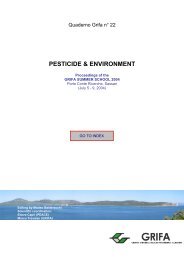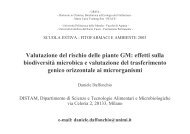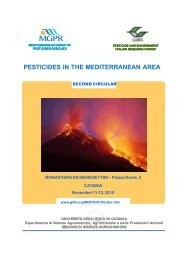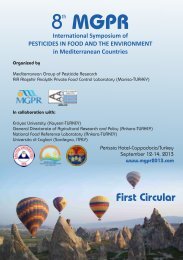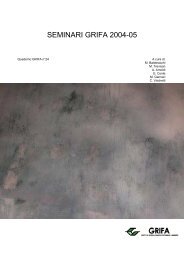International Congress BIOLOGICAL PRODUCTS - Gruppo di ...
International Congress BIOLOGICAL PRODUCTS - Gruppo di ...
International Congress BIOLOGICAL PRODUCTS - Gruppo di ...
Create successful ePaper yourself
Turn your PDF publications into a flip-book with our unique Google optimized e-Paper software.
RELIABILITY AND PROSPECTIVES FOR THE <strong>BIOLOGICAL</strong> CONTROL OF PHYTOPHAGOUS<br />
INSECTS<br />
Giuseppe Carlo Lozzia, Ivo E. Rigamonti<br />
Istituto <strong>di</strong> Entomologia agraria, Università degli Stu<strong>di</strong> <strong>di</strong> Milano<br />
In the last years there has been an explosion in the widespread of foodstuffs and other “biological” products that are<br />
associated with an image of naturalness and hygienic safety by the public, even if these concepts are wrongly thought to<br />
be closely linked. In reality, notwithstan<strong>di</strong>ng the great emphasis on the use of “natural” techniques and of the exclusion<br />
of artificial products, biological agriculture is not so <strong>di</strong>fferent from the most modern “conventional” strategies, and is<br />
largely based on the use of active ingre<strong>di</strong>ents, which are natural but still toxic, that have all the problems of “pesticides”<br />
(residues on foodstuffs, side effects on non-target organisms, etcetera) but on a <strong>di</strong>fferent scale. This situation, both for<br />
biological and tra<strong>di</strong>tional agriculture, is not due to a “strategic” trust in pesticides but to a lack of total efficacy in low<br />
impact management techniques, and in particular to biological control.<br />
Up to now, as a matter of fact, there is no culture of a certain importance for which the pest management can be given<br />
solely to, or even mainly to, biological control. The situation is decidedly better if we only refer to animal organisms. In<br />
this case there are consolidated strategies, at least theoretically; which refer to the reconstitution of balances and to the<br />
improvement of the action against natural enemies, which are carried out in practice through the use of four<br />
“techniques”: the <strong>di</strong>ffusion of antagonists, the elimination of worrying sources and the adoption of environmental and<br />
cultural management measures. Furthermore, the use of pheromones and other “modern” methods gives the possibility<br />
to enlarge the possibilities of success. Modern strategies are based on this framework especially with the understan<strong>di</strong>ng<br />
that a culture is a real ecosystem where limiting natural factors have a considerably important role. The most recent<br />
research is analysing the influence of <strong>di</strong>fferent cultural practices on the coenosys settled in the agro-ecosystem. The aim<br />
of all this is, on the one hand to favour the <strong>di</strong>ffusion of techniques with beneficial effects, and on the other to limit the<br />
repercussions of harmful interventions which cannot be eliminated, as some phytosanitary treatments (Bassino, 1987).<br />
One of the areas where the use of biological control practices is widely used, is in glasshouses cultures. The quick<br />
succession of cultures one <strong>di</strong>fferent from the other, with brief periods when there are no cultures, create a very<br />
particular environment where techniques of permanent biological control of phytophagous insects have no possibility of<br />
success. For this reason, there are usually routine “inundative” releases of antagonists in glasshouses and in tunnels.<br />
Using this strategy the biological tool is almost like a chemical treatment. Large quantities of predators or parasitoids<br />
are introduced into the structure in order to quickly bring down the population of the target pest and to keep it thereafter<br />
under the damage level until the end of the cultivation cycle. Often the release has to be repeated over and over again<br />
and more than one species of antagonists are introduced. In these environments phytophagous insects with determinate<br />
characteristics tend to become affirmed (polyphagous, high number of generations, very prolific) which are able to<br />
damage the cultures that follow, that, as already mentioned, can be very <strong>di</strong>fferent one from another, and in any case the<br />
species always tend to be the same ones. Numerous Rhynchota are particularly abundant (whiteflies, aphids, scale<br />
insects), but Agromyzidae Diptera can also be easily found, as well as some Thysanoptera (Frankliniella occidentalis<br />
(Pergande), Heliothrips haemorrhoidalis (Bouché), Thrips tabaci Lindemann) and spider mites. The low number of pest<br />
species makes it possible for key antagonists to be restricted to a few units. All this has led to the birth and the <strong>di</strong>ffusion<br />
of structures, the commercial insectary, that have become similar in organisation to an industry, whereby the most<br />
important natural enemies of every phytophagous insect is bred in large quantities and after put on sale on a large scale.<br />
The bree<strong>di</strong>ng of auxiliaries is very complex (figure 1) requiring the development of refined and very reliable<br />
techniques.<br />
PDF creato con FinePrint pdfFactory versione <strong>di</strong>mostrativa http://www.secom.re.it/fineprint<br />
11



